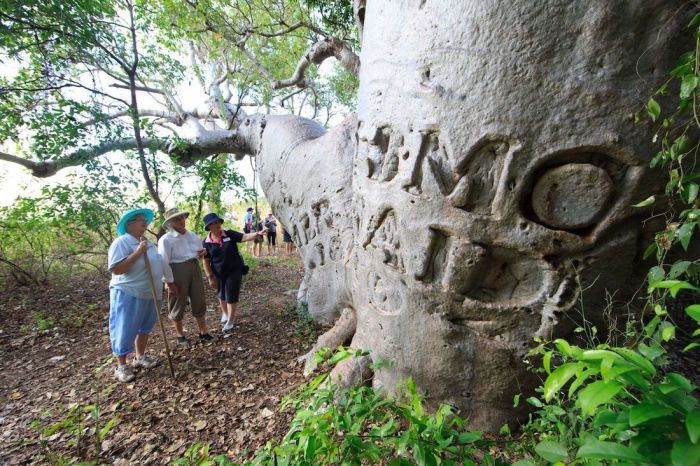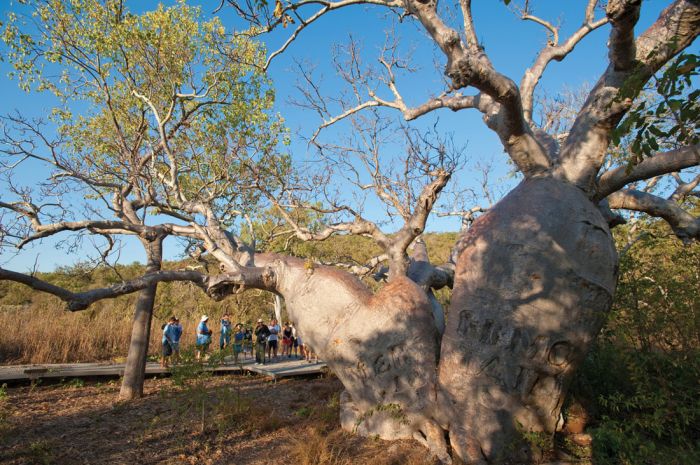
If you’ve already had the good fortune to cruise Western Australia’s Kimberley Coast, or even if it’s still on your bucket list, then you’re probably familiar with the famous ‘Mermaid Boab Tree’.
Located in tranquil Careening Bay, some 450 kilometres as the crow flies north-east of the remote township of Broome, this massive Adansonia Gregorii (the boab’s more formal Latin name) might not be as well-known as prominent Kimberley landmarks such as Horizontal Falls or Montgomery Reef, or as old as the region’s Gwion Gwion (Bradshaw) rock art, but it does mark a very important period in the early exploration of Australia’s northern coastline.
And in 2020, this magnificent tree marks a special bicentenary, and we think that is well worth celebrating.
But first, let’s turn the clock back to 1820 and discover how the Mermaid Boab Tree came to be.
Whether you’re reading up on early exploration of the Kimberley Coast, or sitting on board an expedition ship like the new Coral Adventurer or the 18-passenger Kimberley Quest II taking in a presentation from a guest lecturer, Phillip Parker King is a name you will come to know very well. For although Matthew Flinders had years earlier circumnavigated Australia, and French explorer Baudin had undertaken a rudimentary survey in 1801, it was Parker King who first mapped this unforgiving coastline with any degree of accuracy during the early 1800s.
Between 1818 and 1820, Parker King led three expeditions along the Kimberley coast aboard his 76-tonne cutter HMS Mermaid. Parker King had been tasked by the admiralty to discover whether there were any rivers along the coast 'likely to lead to an interior navigation into this great continent'. In addition to carefully mapping the coast, he had also been instructed to collect information about the topography, geology, flora and fauna, and the local indigenous population of the region, and whether there were any prospects of developing trade with them.
It was during Parker King’s third expedition, in 1820, that his trusty little ship Mermaid began taking on water after running aground off the central Queensland coast. By the time the expedition had reached the waters of the Kimberley in September of that same year, it was evident to Parker King and his crew that the voyage would have to be abandoned unless necessary repairs could be carried out on Mermaid’s leaky hull.
So, on high tide, Parker King gave the order to careen the Mermaid on a sandy beach in the area that is now known as Careening Bay. It took ten days to repair Mermaid’s damaged hull, using metal salvaged from a nearby shipwreck. It was during this ten days at camp that one of Mermaid’s carpenters came across a small boab tree, set just back off the beach, and famously carved the words ‘HMC Mermaid 1820’ into the trunk.
After Mermaid’s repairs were satisfactorily completed, she was refloated and once again set off on her expedition to chart the Kimberley Coast, the inscription in the boab tree all but forgotten for well over a century. Fast-forwarding 200 years to the tree’s approaching bicentenary, the little boab has grown to over 12-metres in circumference, and her engraving remains a monument to those very early and dangerous expeditions along the coast. These days, modern expeditioners from aboard luxurious small ships regularly venture ashore in Careening Bay to photograph and sketch, or simply marvel at such a magnificent marker to history.
Over the years, the tree’s age and increasing number of visitors has put pressure on its survival, with the huge weight of its branches resulting in small cracks appearing, and a fear among some arborists that the tree might even collapse. Recent conservation efforts have included the construction of a metal boardwalk to protect the tree’s root system and there is a planned pruning which will take some of the weight out of the branches, relieving pressure on the main trunk. It is hoped that this pruning will prolong the tree’s life for future generations to enjoy – perhaps even another 200 years if we’re lucky.
So, there you have the intriguing story of Careening Bay’s Mermaid Boab Tree. From humble beginnings (you could even argue it was graffiti akin to scratching your name into an old school desk) to one of the Kimberley Coast’s most important historical markers 200 years later.
Why not celebrate this magnificent milestone by making 2020 the year you see the Mermaid Boab Tree for yourself? Contact the expert team at Expedition Cruise Specialists today on 1800 90 20 80 for more details about the various Kimberley cruises calling in at Careening Bay in 2020.

Experience the Mermaid Boab Tree from aboard the 18-passenger Kimberley Quest II.














